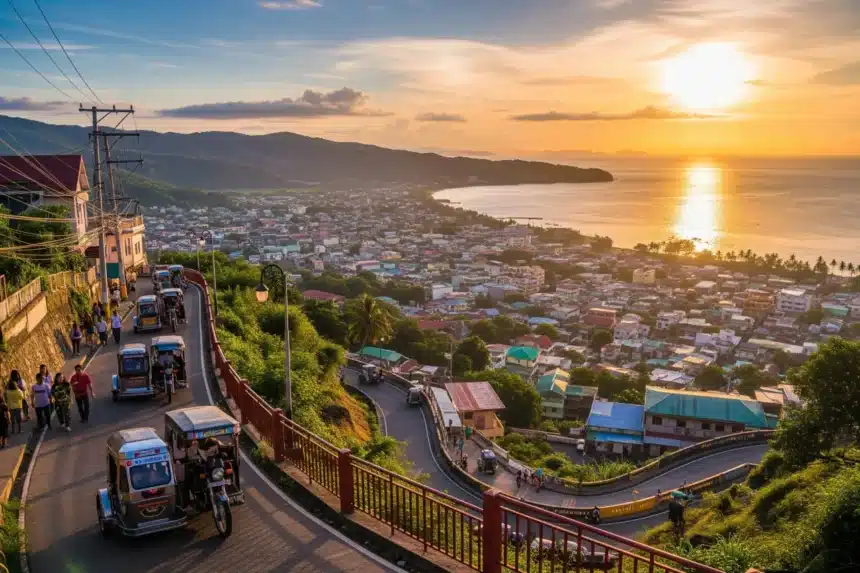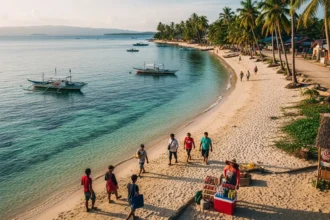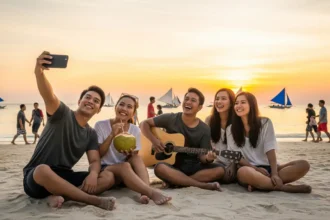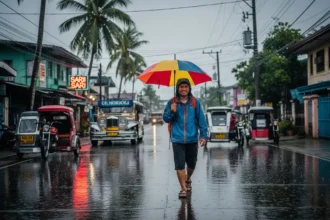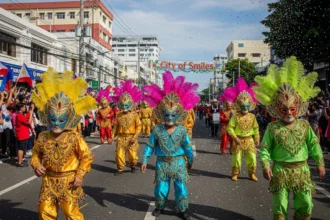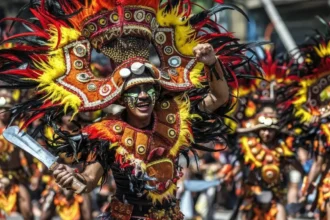There’s a certain thrill that comes with traveling in the Philippines-a moment in every destination that defines its unique character. In Pagadian City, that moment happens the second you hop into your first tricycle. As it effortlessly climbs a steep, 40-degree incline, you realize this is no ordinary city. Dubbed the “Little Hong Kong of the South,” Pagadian is a city built on hills, a place of dramatic landscapes, resilient people, and ingenious solutions to everyday life.
- 📜 A Glimpse into Pagadian’s Past
- 🛫 Planning Your Trip: The Gateway to the Peninsula
- 🌄 Things to Do in Pagadian: Hills, Islands, and Waterfalls
- 🗓️ A Suggested 3-Day Pagadian Itinerary
- 🍽️ A Taste of Pagadian: What to Eat
- 🌟 Hidden Gems Around Pagadian
- 🎊 The Spirit of Thanksgiving: Pasalamat Festival
- Frequently Asked Questions about Traveling to Pagadian City
- ❤️ A Final Word from the Road
Located in the heart of Zamboanga del Sur, Pagadian is a city that literally rises from the coast of Illana Bay, offering stunning vistas from almost every corner. It’s a bustling regional center where commerce, nature, and a rich blend of Christian, Muslim, and Subanen cultures converge. For too long, it has remained one of Mindanao’s best-kept secrets. This Pagadian travel guide is your invitation to discover a city that’s as unique in its engineering as it is warm in its hospitality, a place that promises an adventure unlike any other.
📜 A Glimpse into Pagadian’s Past
Pagadian’s history is rooted in the Subanen people, the original inhabitants of the region, who named the area “Pagad,” meaning “to wait,” as it was a place they waited for good weather before crossing the bay. Formally established as a town in 1937, it grew into a chartered city, becoming a vital hub for trade and governance in the Zamboanga Peninsula. Its challenging terrain shaped not just its architecture but the very character of its people-hardworking, adaptable, and innovative.
🛫 Planning Your Trip: The Gateway to the Peninsula
Pagadian City is more than just the capital of Zamboanga del Sur-it’s also a major transportation hub, making it surprisingly accessible for travelers who want to explore the western Mindanao peninsula. Whether you’re flying in for business, stopping over before heading to nearby provinces, or beginning an adventure through Mindanao, Pagadian offers both convenience and connectivity.
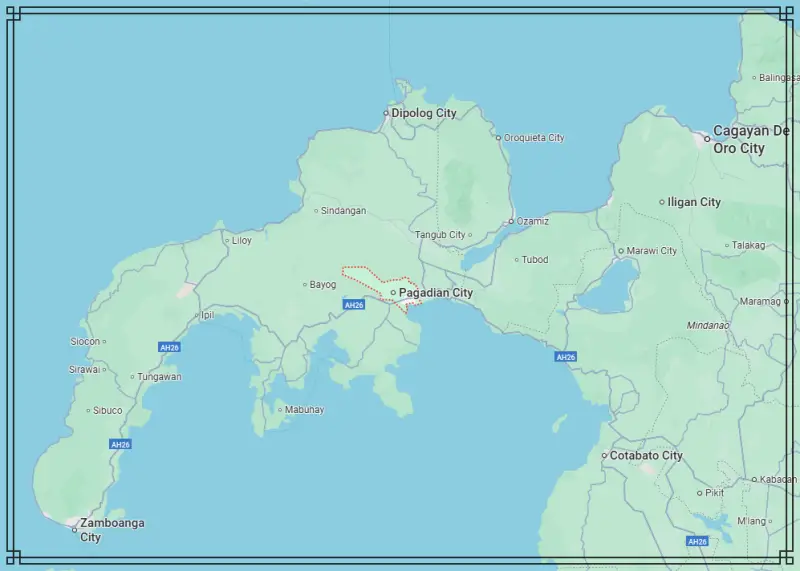
✈️ How to Get to Pagadian
By Air – The fastest way to reach Pagadian is through Pagadian Airport (PAG), located just a few kilometers from the city proper. Major airlines like Cebu Pacific and PAL Express operate regular flights from Manila and Cebu, with travel times averaging 1.5 to 2 hours. The airport is small but efficient, with taxis, tricycles, and vans available outside for a quick transfer into the city.
By Land – For those already in Mindanao, Pagadian is well-connected by bus and van routes as part of the main highway network.
-
From Zamboanga City: Around 6–7 hours by bus or private vehicle.
-
From Cagayan de Oro: Approximately 7–8 hours by land.
-
From Dipolog or Ozamiz: About 4–5 hours.
-
From Cotabato City: Roughly 6–7 hours.
By Sea – While Pagadian no longer has frequent passenger ferries, nearby ports like Ozamiz or Zamboanga City provide sea connections if you’re combining ship travel with a bus ride.
🏨 Where to Stay
Pagadian has a modest but diverse range of accommodations, catering to both budget-conscious travelers and those who prefer more comfortable amenities.
Mid-Range Hotels – If you want a balance of comfort and convenience, Hotel Guillermo, Pagadian Bay Plaza Hotel, and Hotel Alindahaw are solid choices. Most are located in or near the city center, with easy access to restaurants, malls, and transport hubs.
Budget-Friendly Inns – For practical stays, GV Hotel and local pension houses offer simple, secure rooms at affordable rates. These are ideal for backpackers or travelers who plan to spend most of their time exploring outside.
Pagadian’s role as a hub makes it a practical base camp-you can explore nearby provinces during the day and return to a comfortable room at night. Whether you fly in or take the long road trip, the city’s accessibility and straightforward accommodations ensure a smooth start to your Mindanao adventure.
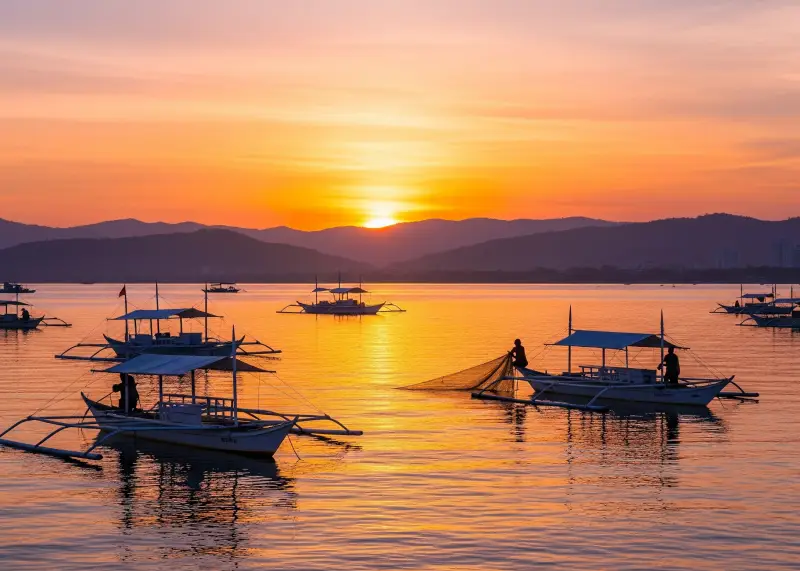
🌄 Things to Do in Pagadian: Hills, Islands, and Waterfalls
Pagadian’s attractions blend urban character with natural beauty, giving travelers a unique mix of city adventures, serene island getaways, and refreshing waterfalls. Whether you’re into cultural strolls, seaside escapes, or scenic views, the city offers experiences you won’t find anywhere else in Mindanao.
🏙️ Must-Do Urban Experiences
Ride the Famous Inclined Tricycle – Pagadian’s iconic tricycles are tilted at a 25–40° angle, specially designed to climb the city’s hilly roads. A ride through the steep streets isn’t just practical-it’s a thrill and a cultural trademark of Pagadian. No visit is complete without hopping on one of these colorful rides.
Catch the Sunset at the Rotonda – Perched atop a hill, the Pagadian Rotonda offers sweeping views of the city cascading down to Illana Bay. The panoramic sight at golden hour is nothing short of magical. Locals and travelers alike gather here to watch the sun dip below the horizon, painting the sky in vivid shades of orange and pink.
Stroll Through Plaza Luz – At the city’s heart lies Plaza Luz, a green sanctuary where locals come to unwind. The park is home to a charming dancing fountain, landscaped gardens, and open spaces perfect for a late-afternoon stroll. It’s also a great place to people-watch and soak in the everyday rhythm of Pagadian life.
🌴 Nature and Island Escapes
Island Hopping at Dao Dao Islands – Just 10–15 minutes by boat from the city wharf, the Dao Dao Islands are Pagadian’s seaside gems. Dao Dao Dako (Big Dao Dao) is a seven-hectare island with sandy shores and vibrant coral reefs, ideal for snorkeling and swimming. During low tide, the smaller Dao Dao Gamay (Small Dao Dao) emerges as a picturesque sandbar-perfect for barefoot walks and photos.
Marvel at Pulacan Falls – Located about 12 kilometers away in Labangan, Pulacan Falls is a majestic natural wonder. Its wide, multi-tiered cascades crash down into a refreshing pool, surrounded by lush forests. A forest park nearby makes it a popular spot for picnics and day trips, offering both relaxation and adventure in one setting.
Pagadian’s mix of steep hills, sunset viewpoints, nearby islands, and waterfalls creates a travel experience that feels both intimate and adventurous. Whether you’re exploring the city streets on a tricycle or wading into the waters of Dao Dao, every activity here ties back to Pagadian’s unique identity-a gateway city where the urban and the natural meet seamlessly.
🗓️ A Suggested 3-Day Pagadian Itinerary
This itinerary is designed to give you the full Pagadian experience, from its hilly streets to its tranquil islands.
Day 1: Arrival and City Immersion
- Morning: Arrive at Pagadian Airport, check into your hotel.
- Afternoon: Your first order of business: hire an inclined tricycle for a city tour. Ask the driver to take you through the steepest streets for the full experience. Visit Plaza Luz and the Sto. Niño Cathedral.
- Evening: Head up to the Rotonda an hour before sunset. Find a good spot, enjoy some street food, and watch the city lights begin to twinkle below as the sun goes down.
Day 2: Island Life and Local Markets
- Morning: Go to the city wharf (BPA Port) and hire a boat to take you to the Dao Dao Islands. Spend the morning swimming, snorkeling, and enjoying the quiet island atmosphere.
- Afternoon: Return to the mainland and explore the Pagadian City Public Market (Agora). This is the best place to see the local catch and perhaps buy some fresh seafood for a restaurant to cook for you (paluto).
- Evening: Enjoy a fresh seafood dinner at one of the restaurants along the baywalk or F.S. Pajares Avenue.
Day 3: Waterfalls and Departure
- Morning: Hire a tricycle or van for a trip to Pulacan Falls in Labangan. Spend a couple of hours enjoying the scenery and the powerful rush of the water.
- Afternoon: Head back to the city for some last-minute pasalubong shopping at the Gaisano Capital mall or local delicacy shops.
- Evening: Enjoy a final Pagadian dinner before heading to the airport for your flight home.
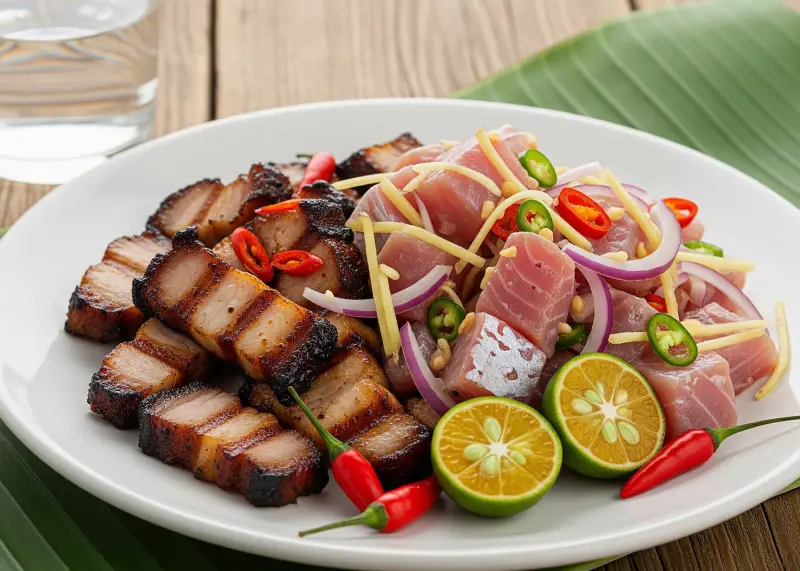
🍽️ A Taste of Pagadian: What to Eat
Pagadian’s cuisine is a hearty and flavorful mix of Visayan and Muslim Mindanao influences, with a strong emphasis on fresh, local ingredients.
| Must-Try Dish/Delicacy | Description |
|---|---|
| Fresh Seafood | Being a coastal city, the seafood is a highlight. Look for grilled tuna (panga or belly), squid, and a variety of fresh fish. |
| Sinuglaw | A perfect combination of two Filipino favorites: sinugba (grilled pork belly) and kinilaw (raw fish ceviche), mixed together for a smoky, tangy, and savory dish. |
| Kalderetang Kambing | A rich and spicy goat stew that is a local specialty. The goat meat is incredibly tender and cooked in a tomato-based sauce with vegetables. |
| Local Pastries | Look for local bakeries selling unique pastries and delicacies that blend local flavors. |
🌟 Hidden Gems Around Pagadian
If you have extra time in Pagadian, venture a little further out to discover hidden gems that showcase the raw beauty of Zamboanga del Sur. These spots may not be as famous as Dao Dao or Pulacan Falls, but they offer equally memorable experiences away from the crowds.
Manga Falls (Pagadian City) – Just 7 kilometers from the city proper, Manga Falls is a twin cascade surrounded by dense forest and fresh mountain air. It’s a quiet retreat perfect for nature lovers, and its cool waters provide a refreshing dip on hot afternoons.
Lison Valley (Pagadian City) – A scenic highland area that feels worlds away from the bustle of downtown. Rolling hills, wide farmlands, and crisp mountain breezes make it a favorite for road trips and photography. It’s also known for adventure trails popular with bikers and hikers.
Lakewood (Lakewood, Zamboanga del Sur) – Roughly 45 minutes to an hour from Pagadian lies Lakewood, a serene crater lake ringed by hills. It’s famous for its clear blue waters and the rustic accommodations that dot its shores. Visitors can ride a boat across the lake, fish, or simply relax while taking in the stunning mountain backdrop.
Ditoray Falls (Barangay Ditoray, Pagadian) – A lesser-known waterfall that requires a bit of trekking, rewarding visitors with a more secluded and peaceful atmosphere. It’s ideal for those who prefer quiet escapes in nature.
These hidden gems prove that Pagadian isn’t just a stopover city-it’s a gateway to unspoiled landscapes and cultural experiences. For travelers willing to explore beyond the main attractions, these spots reveal the city’s quieter, more soulful side.
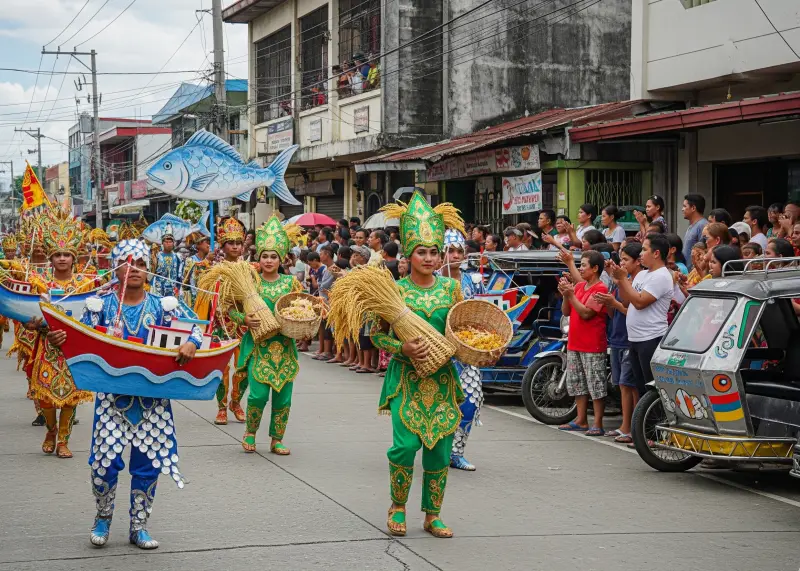
🎊 The Spirit of Thanksgiving: Pasalamat Festival
If your visit falls on the third Sunday of January, you’re in for a treat. The Pasalamat Festival is Pagadian’s grandest celebration, held in honor of its patron saint, the Santo Niño. The name “Pasalamat” means thanksgiving. The festival is a vibrant explosion of faith and culture, highlighted by a fluvial parade on Illana Bay and a spectacular street dancing competition where contingents from different parts of the province showcase their colorful costumes and energetic choreography.
Frequently Asked Questions about Traveling to Pagadian City
-
What is Pagadian City known as, and why does it feel unique?
Pagadian is often called the “Little Hong Kong of the South” because of its steep hills that slope down toward Illana Bay. Its hilly terrain, iconic inclined tricycles, and mix of coastal & highland views give it a distinct character unlike many other cities in Mindanao. -
How do I get to Pagadian City from other major Philippine hubs?
You can fly in via Pagadian Airport (PAG) with flights from Manila or Cebu. If you’re already in Mindanao, there are buses or vans from places like Zamboanga City, Cagayan de Oro, Dipolog, Ozamiz, or Cotabato. The travel time will depend on distance-expect several hours by land. -
What’s the best time of year to visit Pagadian?
If you want good weather for outdoor stuff like island hopping or waterfall visits, go during the dry season (December to May). If you’re interested in festivals and local culture, try to catch Pasalamat Festival, held the third Sunday of January. -
Is it safe to travel around Pagadian City for tourists?
Generally, yes. Pagadian is relatively peaceful, and locals tend to be warm and welcoming. Just use common sense-watch your belongings, avoid sketchy areas at night, and maybe ask locals for suggestions on safe routes or places. As always, being aware helps. -
What are must-do things when I’m in Pagadian?
First ride the inclined tricycles to get a feel of the hills, then go to the Rotonda for sunset views. Explore Dao Dao Islands for beach and snorkeling, visit Pulacan Falls, stroll around Plaza Luz, and sample local markets and eats like fresh seafood and sinuglaw. -
Where should I stay in Pagadian, especially if I’m on a budget?
There are budget inns and guesthouses near the city center that are secure and clean. If you want a bit more comfort, mid-range hotels like Hotel Guillermo or Pagadian Bay Plaza offer better amenities without being too expensive. Choose something close to transport hubs for convenience. -
What food should I try in Pagadian that locals love?
Fresh coastal seafood is a must (grilled fish, squid, etc.). Try sinuglaw (a mix of grilled pork + kinilaw), kalderetang kambing (goat stew), and local pastries/delicacies from markets or small bakeries. It’s a flavor mix of coastal, Visayan, and Mindanao influences. -
Are there hidden spots around Pagadian worth exploring off the typical path?
Definitely. Manga Falls is just a short trip from the city and usually less crowded. Lison Valley gives those rolling-hill countryside vibes great for photos. Lakewood is nice if you want calmer nature, boating, or just relaxing by a lake. Ditoray Falls is for those willing to trek a bit more. -
What are good pasalubong ideas from Pagadian?
Dried fish and squid are local staples. Seafood-based snacks, peanut products, and local baked goods also make good pasalubong. You’ll find these in the public markets or small shops around town. -
How reliable is mobile/internet coverage in Pagadian and its surroundings?
In the city proper, mobile signal and internet are pretty good with most major networks. When you head out to islands, remote waterfalls, or very rural areas, expect weaker signal or occasional drop-outs-so plan ahead (download maps, let someone know where you’ll be going, etc.).
❤️ A Final Word from the Road
I’ve driven through many cities in my travels, but few have a character as distinct as Pagadian. It’s a city that wears its geography on its sleeve-or rather, on the angle of its tricycles. There’s an undeniable energy here, a sense of a city constantly moving, climbing, and looking forward.
To me, that inclined tricycle is a perfect metaphor for Pagadian itself: innovative, resilient, and always moving upwards. This is a city that doesn’t just adapt to its challenges; it turns them into its most charming and defining feature. A trip to Pagadian is a reminder that the most interesting destinations are rarely the ones that are flat and easy, but the ones with hills to climb and stunning views to earn.



